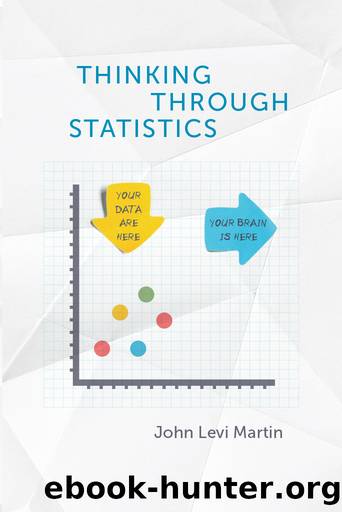Thinking Through Statistics by John Levi Martin

Author:John Levi Martin [Martin, John Levi]
Language: eng
Format: epub
Tags: Social Science, General, Sociology, Mathematics, Probability & Statistics, Business & Economics
ISBN: 9780226567778
Google: dXllDwAAQBAJ
Publisher: University of Chicago Press
Published: 2018-08-21T05:17:31+00:00
* 7 *
Time and Space
Introduction
In the past two chapters, we considered what changes we might need to make to our general control strategy when we embed our data in structuresâso far, only in aggregates. In the next two chapters, we consider when these embeddings are themselves structured. In this chapter, weâre going to look at when these embeddings are times or places. The central problem we will focus on is not an issue of statistical interdependence and the correction of standard errors. Itâs a much bigger one: there is information about similarity between our cases that is not gathered by us in our data regime, but is held in the world. When observations were made probably tells us something about the cases . . . but we donât necessarily know what. Ditto where.
Most of our problems, we recall, come from the fact that we donât have the right model. Something is happening, and you donât know what it is.1 And usually, some of our omitted predictors are, contrary to our optimistic wishes, correlated with our included ones. The fact that unobserved predictors are likely to be more similar among cases close in time and/or space than those farther away leads to statistical problems. But it can also provide ways of uncovering, and perhaps correcting, problems we wouldnât otherwise know about! That is, if we assume that events closer in space-time are more likely to share unmeasured predictors, we can push on the robustness of our analyses.
Interestingly, weâve had very different orientations when it comes to time and to space. Thatâs in large part due to the fact that we assume that time and space are intrinsically different. Timeââmonarchical time,â in Bergsonâs wordsâis inflexible and possesses its own principles whereby it forces an order upon our experiences. The past is ever inaccessible to us. Spaceââdemocratic spaceââis the opposite. While time is inflexible, space is generous and yielding. Unlike with time, when it comes to space, we choose how we proceed through it to order our experiences. For this reason, weâve tended to trust time to do things for us that it doesnât, and so analyses turning on time have tended to be weaker and worser than most conventional analyses, while those using space have been stronger and more conservative.
But for most of our analytic purposes, the way in which time and space affect our analyses is more similar than it is different. The directionality of time has given many sociologists false assurances; directionality rarely solves problems of omitted predictors. Let me give a brief example: you have an awesome set of dataâall the babies who were born in Sweden from 1900 to 2000. You want to use this to estimate, say, the degree to which âfamilyâ (whether genetic or social heritage) seems to explain some behaviorâby comparing brothers within families to people across families.
But, given this time span, brothers are more likely to be born close in time, and to experience similar social conditions, than non-brothers. Thatâs going to increase the amount of the variation that seems to be within family, but is really in time.
Download
This site does not store any files on its server. We only index and link to content provided by other sites. Please contact the content providers to delete copyright contents if any and email us, we'll remove relevant links or contents immediately.
Harry Potter and the Goblet Of Fire by J.K. Rowling(3024)
Never by Ken Follett(2871)
Shadow of Night by Deborah Harkness(2709)
Ogilvy on Advertising by David Ogilvy(2677)
Zero to IPO: Over $1 Trillion of Actionable Advice from the World's Most Successful Entrepreneurs by Frederic Kerrest(2374)
The Man Who Died Twice by Richard Osman(2289)
Machine Learning at Scale with H2O by Gregory Keys | David Whiting(2263)
Book of Life by Deborah Harkness(2258)
How Proust Can Change Your Life by Alain De Botton(2255)
My Brilliant Friend by Elena Ferrante(2217)
0041152001443424520 .pdf by Unknown(2213)
The Tipping Point by Malcolm Gladwell(2200)
How to Pay Zero Taxes, 2018 by Jeff A. Schnepper(2094)
Will by Will Smith(2032)
Purple Hibiscus by Chimamanda Ngozi Adichie(1977)
Hooked: A Dark, Contemporary Romance (Never After Series) by Emily McIntire(1932)
Borders by unknow(1779)
Rationality by Steven Pinker(1760)
Daughter of Smoke and Bone by Laini Taylor(1737)
